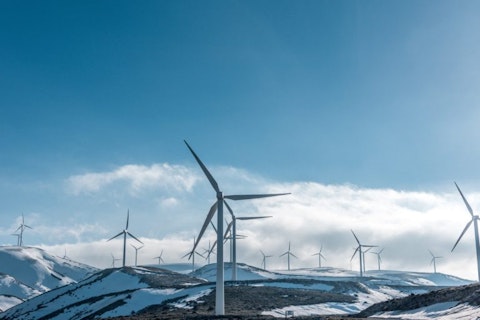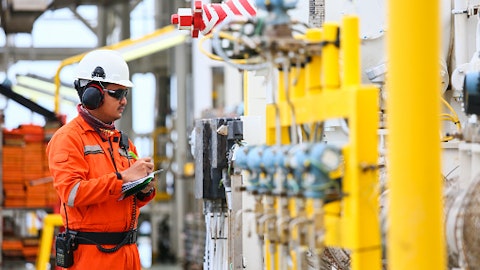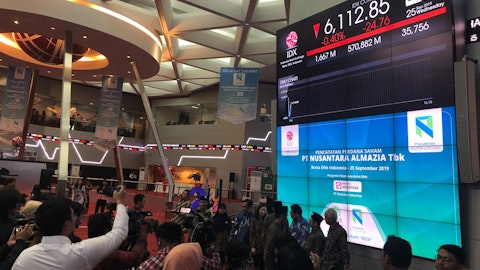Valero Energy Corporation (NYSE:VLO) Q4 2022 Earnings Call Transcript January 26, 2023
Operator: Greetings and welcome to the Valero’s Fourth Quarter 2022 Earnings Conference Call. At this time, all participants are in a listen-only mode. A brief question-and-answer session will follow the formal presentation. As a reminder, this conference is being recorded. It is now my pleasure to introduce your host, Homer Bhullar, Vice President, Investor Relations. Thank you, Mr. Bhullar. You may begin.
Homer Bhullar: Good morning everyone and welcome to Valero Energy Corporation’s fourth quarter 2022 earnings conference call. With me today are Joe Gorder, our Chairman and CEO; Lane Riggs, our President and COO; Jason Fraser, our Executive Vice President and CFO; Gary Simmons, our Executive Vice President and Chief Commercial Officer; and several other members of Valero’s senior management team. If you have not received the earnings release and would like a copy, you can find one on our website at investorvalero.com. Also attached to the earnings release are tables that provide additional financial information on our business segments and reconciliations and disclosures for adjusted metrics mentioned on this call. If you have any questions after reviewing these tables, please feel free to contact our Investor Relations team after the call.
I would now like to direct your attention to the forward-looking statement disclaimer contained in the press release. In summary, it says that statements in the press release and on this conference call that state the company’s or management’s expectations or predictions of the future are forward-looking statements intended to be covered by Safe Harbor provisions under federal securities laws. There are many factors that could cause actual results to differ from our expectations, including those we’ve described in our filings with the SEC. Now, I’ll turn the call over to Joe for opening remarks.
Joe Gorder: Thanks Homer and good morning everyone. We finished the year strong with our refineries operating at 97% capacity utilization in a favorable refining margin environment. In fact, this is the highest refinery utilization for our refining system since 2018. I’m also proud to share that 2022 was the best year ever for combined employee and contractor safety, which is a testament to our long-standing commitment to safe, reliable, and environmentally responsible operations. As we saw during most of 2022, refining margins were supported by low product inventories, which resulted from the significant permanent global refinery shutdowns and the continued recovery in product demand. Our refining system also benefited from heavily discounted sour crude oils and fuel oils.
These discounts were driven by increased sour crude oil supply, high freight rates, and the impact from the IMO 2020 regulation for lower sulfur marine fuels. Also, high natural gas prices in Europe incentivize European refiners to process sweet crude oils in lieu of sour crude oils, adding further pressure on sour crude oils. And our refining projects that are focused on reducing cost and improving margin capture remain on track. The Port Arthur Coker project is expected to be completed in the second quarter of 2023 and will increase refinery’s throughput capacity and ability to process incremental volumes of sour crude oils and residual feedstocks while also improving turnaround efficiency. In our Renewable Diesel segment, we continue to expand operations, and we set another sales volume record in the fourth quarter with the successful commissioning and start-up of the new DGD Port Arthur renewable diesel plant in November.
That project was completed under budget and ahead of schedule and brings DGD’s annual production capacity to approximately 1.2 billion gallons of renewable diesel and 50 million gallons of renewable naphtha. In the Ethanol segment, BlackRock and Navigators carbon sequestration project is still progressing on schedule and is expected to begin start-up activities in late 2024. We expect to be the anchor shipper with eight of our ethanol plants connected to this system, which is expected to result in the production of a lower carbon intensity ethanol product that should significantly improve the margin profile and competitive positioning of the business. And we continue to advance other low-carbon opportunities such as sustainable aviation fuel, renewable hydrogen and additional renewable naphtha and carbon sequestration projects.
Our gated process helps ensure these projects meet our minimum return threshold. On the financial side, we continue to strengthen our balance sheet, paying off all of the incremental debt incurred during the pandemic and ending the year with a net debt to-capitalization ratio of 21%. Looking ahead, we expect low product inventories and continued increase in product demand to support margins, particularly for US coastal refiners that have crude oil supply and natural gas advantages relative to global refineries. And we continue to see large discounts for heavy sour crude oils and fuel oils that we can process in our system. The startup of the Port Arthur Coker is also expected to have a significant earnings contribution in the back half of 2023, supported by wide sour crude oil differentials and strong diesel margins.
In closing, we’re encouraged by the refining outlook, which, coupled with the contribution from our strategic growth projects in refining and renewable fuels, should continue to strengthen our long-term competitive advantage and shareholder returns. So with that, Homer, I’ll hand the call back to you.
Homer Bhullar: Thanks, Joe. For the fourth quarter of 2022, net income attributable to Valero stockholders was $3.1 billion or $8.15 per share, compared to $1 billion or $2.46 per share for the fourth quarter of 2021. Fourth quarter 2022 adjusted net income attributable to Valero stockholders was $3.2 billion or $8.45 per share compared to $988 million or $2.41 per share for the fourth quarter of 2021. For 2022, net income attributable to Valero stockholders was $11.5 billion or $29.04 per share compared to $930 million or $2.27 per share in 2021. 2022 adjusted net income attributable to Valero stockholders was $11.6 billion or $29.16 per share compared to $1.2 billion or $2.81 per share in 2021. For reconciliations to adjusted amounts, please refer to the earnings release and the accompanying financial tables.
The Refining segment reported $4.3 billion of operating income for the fourth quarter of 2022 compared to $1.3 billion for the fourth quarter of 2021. Adjusted operating income for the fourth quarter of 2022 was $4.4 billion compared to $1.1 billion for the fourth quarter of 2021. Refining throughput volumes in the fourth quarter of 2022 averaged 3 million barrels per day. Throughput capacity utilization was 97% in the fourth quarter of 2022. Refining cash operating expenses of $5 per barrel in the fourth quarter of 2022 were $0.14 per barrel higher than the fourth quarter of 2021, primarily attributed to higher natural gas prices. Renewable Diesel segment operating income was $261 million for the fourth quarter of 2022, compared to $150 million for the fourth quarter of 2021.

Photo by Jason Blackeye on Unsplash
Renewable Diesel sales volumes averaged 2.4 million gallons per day in the fourth quarter of 2022, which was 851,000 gallons per day higher than the fourth quarter of 2021. The higher sales volumes were due to the impact of additional volumes from the DGD St. Charles plant expansion and the fourth quarter 2022 start-up of the DGD Port Arthur plant. The Ethanol segment reported $7 million of operating income for the fourth quarter of 2022, compared to $474 million for the fourth quarter of 2021. Adjusted operating income for the fourth quarter of 2022 was $69 million compared to $475 million for the fourth quarter of 2021. Ethanol production volumes averaged 4.1 million gallons per day in the fourth quarter of 2022. The higher operating income in the fourth quarter of 2021 was primarily attributed to multi-year high ethanol prices due to strong demand and low inventories.
For the fourth quarter of 2022, G&A expenses were $282 million and net interest expense was $137 million. G&A expenses were $934 million in 2022. Depreciation and amortization expense was $633 million and income tax expense was $1 billion for the fourth quarter of 2022. The annual effective tax rate was 22% for 2022. Net cash provided by operating activities was $4.1 billion in the fourth quarter of 2022 and $12.6 billion for the full year. Excluding the unfavorable change in working capital of $9 million in the fourth quarter and $1.6 billion in 2022 and the other joint venture member share of DGD’s net cash provided by operating activities, excluding changes in DGD’s working capital, adjusted net cash provided by operating activities was $4 billion for the fourth quarter and $13.8 billion for the full year.
Regarding investing activities, we made $640 million of capital investments in the fourth quarter of 2022, of which $349 million was for sustaining the business, including costs for turnarounds, catalysts and regulatory compliance and $291 million was for growing the business. Excluding capital investments attributable to the other joint venture members share of DGD and those related to other variable interest entities, capital investments attributable to Valero were $538 million in the fourth quarter of 2022 and $2.3 billion for the year, which is higher than our annual guidance primarily due to project spend timing on the Port Arthur Coker project and the accelerated completion of the DGD Port Arthur plant. Moving to financing activities.
We returned $2.2 billion to our stockholders in the fourth quarter of 2022 and $6.1 billion in the year, resulting in a 2022 payout ratio of 45% of adjusted net cash provided by operating activities through dividends and stock buybacks. With respect to our balance sheet, we completed additional debt reduction transactions in the fourth quarter that reduced Valero’s debt by $442 million through opportunistic open market repurchases. As Joe noted earlier, this reduction, combined with a series of debt reduction and refinancing transactions since the second half of 2021, have collectively reduced Valero’s debt by over $4 billion. We ended the year with $9.2 billion of total debt, $2.4 billion of finance lease obligations and $4.9 billion of cash and cash equivalents.
The debt-to-capitalization ratio, net of cash and cash equivalents was approximately 21%, down from the pandemic high of 40% at the end of March 2021, which was largely the result of the debt incurred during the height of the COVID-19 pandemic. And we ended the year well capitalized with $5.4 billion of available liquidity, excluding cash. Turning to guidance. We expect capital investments attributable to Valero for 2023 to be approximately $2 billion, which includes expenditures for turnarounds, catalysts and joint venture investments. About $1.5 billion of that is allocated to sustaining the business and $500 million to growth. For modeling our first quarter operations, we expect refining throughput volumes to fall within the following ranges: Gulf Coast at 1.59 million to 1.64 million barrels per day; Mid-Continent at 415,000 to 435,000 barrels per day; West Coast at 245,000 to 265,000 barrels per day; and North Atlantic at 415,000 to 435,000 barrels per day.
We expect refining cash operating expenses in the first quarter to be approximately $4.95 per barrel. With respect to the Renewable Diesel segment, we expect sales volumes to be approximately 1.2 billion gallons in 2023. Operating expenses in 2023 should be $0.49 per gallon, which includes $0.19 per gallon for non-cash costs such as depreciation and amortization. Our Ethanol segment is expected to produce 4 million gallons per day in the first quarter. Operating expenses should average $0.51 per gallon, which includes $0.05 per gallon for noncash costs such as depreciation and amortization. For the first quarter, net interest expense should be about $130 million and total depreciation and amortization expense should be approximately $655 million.
For 2023, we expect G&A expenses, excluding corporate depreciation, to be approximately $925 million. That concludes our opening remarks. Before we open the call to questions, please adhere to our protocol of limiting each turn in the Q&A to two questions. If you have more than two questions, please rejoin the queue as time permits. Please respect this request to ensure other callers have time to ask their questions.
See also 13 Largest Gold Mines in the World and 25 Strongest Countries in Europe by Military Power.
Q&A Session
Follow Valero Energy Corp (NYSE:VLO)
Follow Valero Energy Corp (NYSE:VLO)
Operator: Thank you. The first question is coming from Theresa Chen of Barclays. Please go ahead.
Theresa Chen: Good morning, everyone. Thank you for taking my questions.
Joe Gorder: Good morning, Theresa.
Theresa Chen: My first question is related to good morning. Related to your macro outlook over the near-term. And with respect to Russia, how do you see the EU embargo or price cap on Russian products imports playing out, specifically to the diesel as well as the geo situation?
Gary Simmons: Theresa, this is Gary. I think, initially, we felt like even with the ramp-up in sanctions, you would just see a rebalancing of trade flows much like we saw with crude and resids. Most people in the trade today think that the sanctions will actually result in a reduction in Russian refinery utilization, and you’ll see lower exports of VGO and diesel coming out of Russia when the sanctions take place.
Theresa Chen: Got it. And clearly, there’s been a focus on an elevated amount of maintenance in the first half of this year, plus some unplanned downtime. How big of an impact do you think this will be on near-term refining economics? How real do you think this is? And what are the implications on your own refining earnings taking into account that you have your own maintenance program to work through as well?
Gary Simmons: Yes. So the market is very, very tight. We’re looking at total light product inventories 55 million barrels below the five-year average. And so typically, this is a period of time where you see restocking take place. And with the winter storm outage and high maintenance activity, we just haven’t been able to restock inventories which sets the year up very nicely in terms of refinery margin perspective.
Lane Riggs: And Theresa, this is Lane. So as we’ve been pretty consistent, we don’t do a lot of commentary around our turnaround activity. But nonetheless, I mean, the first quarter and third quarters are heavy turnaround periods when we have turnarounds. And so that’s sort of seasonally, that’s how we execute our maintenance.
Theresa Chen: Thank you.
Operator: Thank you. The next question is coming from Doug Leggate of Bank of America. Please go ahead.
Doug Leggate: Hi, good morning, everyone. Thanks for taking my questions. Happy New Year, guys for those I haven’t spoken to you yet.
Joe Gorder: Thanks, Doug.
Doug Leggate: Joe, I don’t know who you want to direct this too, but I’m curious about coker economics. When you laid out the original plan to bring this online, we were in a very different diesel resid market than we are today. So could you — as you see the earnings power of that facility as it stands, maybe at strip or however you want to characterize it, can you give us an idea what your expectations are relative to what it looked like when you first set out the project? And I’ve got a follow-up, please.
Joe Gorder: Yes. No, Doug, we’ll let Lane take a crack at this one.
Lane Riggs: Hi, Doug. I hope you’re all right. It’s — so just to remind everybody, our FID, I think, was $325 million, that’s sort of based on mid-cycle. We sort of look back at it in sort of 2018, I think the EBITDA was around $420 million. If you sort of fourth quarter, it’s in the order of probably $700 million, maybe a little bit more dollars. So if you use those kind of margins. So obviously, it’s — I don’t know if we have incredible foresight, but it’s great to be lucky. And we lucky to be good, that’s exactly right. So yes, I’d say have assuming all this holds, and I think, at least for our outlook, at least for this year, is that the sort of resid prices and distillate cracks a whole, it will be a — the timing is pretty perfect.
Doug Leggate: Just to be clear, and I know you don’t want to be specific on timing, but would you anticipate this up by the end of the second quarter, or how are you thinking about start-up?
Lane Riggs: I’m going to be fairly specific right here. We’re going to be mechanically complete somewhere late Feb, early March, and we expect oil in somewhere late April or early May.
Doug Leggate: Joe, I hate to do this, but I got to ask the cash return question. Your balance sheet, you’ve managed it or Jason, maybe, back to below COVID levels. Your dividend still hasn’t moved and your share count is now down, I guess, about 7%. So, all things considered, it seems you’ve got a lot of capacity for dividend to restart dividend growth. How can you walk us through what you’re thinking on cash returns? Thanks.
Joe Gorder: Yes. No, Doug, that’s a very fair question and we’ll let Jason share his strategy around this.





